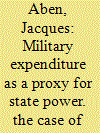| Srl | Item |
| 1 |
ID:
090111


|
|
|
|
|
| Publication |
2009.
|
| Summary/Abstract |
In the published literature, the differences in environmental performance across countries are typically explained using the Environmental Kuznets Curve. The Environmental Kuznets Curve states that pollution initially increases with economic growth. Once GDP per capita reaches a certain level, the relationship reverses. In the present paper, we provide an alternative hypothesis, where budget structure plays an important role in explaining the variations in pollution across the world: the lower the business-related taxes as a share of total tax revenue, the higher the property tax in total tax revenue and the higher the ratio of public health expenditure in total expenditure, then the stronger the incentive of pollution control and the lower the pollution level. Our empirical findings reveal that the budget structure does have an important impact on pollution control. The policy implication of this research is that effective control of environmental pollution requires changes in tax structure and expenditure assignment. This research has important policy implications for China's tax system reform and pollution control efforts.
|
|
|
|
|
|
|
|
|
|
|
|
|
|
|
|
| 2 |
ID:
164525


|
|
|
|
|
| Summary/Abstract |
This paper attempts to build a simple indicator of state power. Military expenditure is the paper’s point of departure, with the definitions given by NATO, SIPRI and others. This definition is discussed and a power version is build, using French budgetary data. Then a defence of the result against traditional or non-traditional critics is presented under an imperative of action. Finally, this concept is enlarged and a new concept of power expenditures is given, one more time using French budgetary data. The conclusion is that this large expenditure concept is an unbiased but imperfect indicator of the will to act, and has to be completed by GDP to indicate the capability to act in the long-run.
|
|
|
|
|
|
|
|
|
|
|
|
|
|
|
|